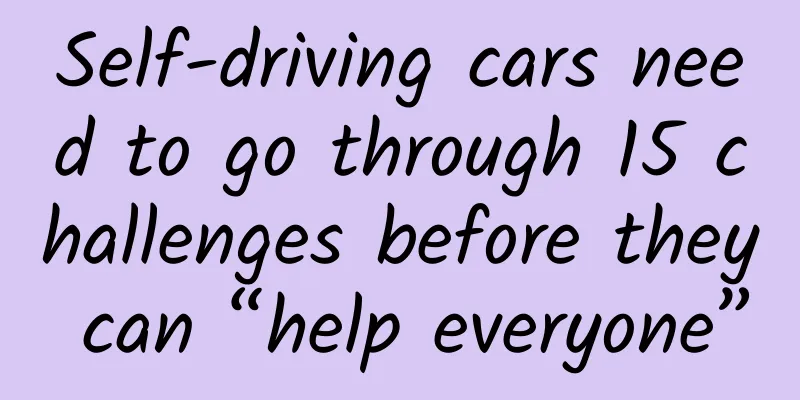Self-driving cars need to go through 15 challenges before they can “help everyone”

|
What does the future of driverless cars have to do with the history of the electric scooter? The electric scooter was also predicted to revolutionize transportation. Steve Jobs once said that cities would be redesigned around the device; John Doerr said it would be bigger than the Internet. The electric scooter was a technical success, but it never had the huge impact on the market that its supporters expected, and instead now only occupies a very narrow market. One can imagine a similar fate for autonomous vehicles (AVs): The technology works well but is confined to narrow market niches, like pre-programmed shuttle routes and slow-moving drones. Some narrow applications, like interstate highways for long-haul trucking, may be very valuable, but not nearly as valuable as many imagine. In order for self-driving cars to become a revolution, a high level of industrialization must be achieved. As a first step, they must establish robust, relatively cheap Uber-like services in cities and suburbs. The industry is banding together to call these services "Transportation as a Service" or "TaaS." In the long run, self-driving cars must be robust enough to be privatized and widespread. This disruptive potential, and the enormous value that comes with it, is motivating hundreds of companies around the world, including some of the largest and wealthiest, including Alphabet, Apple, GM, Ford, Toyota, and SoftBank, to invest billions of dollars in self-driving cars. The work is underway, with some companies and regulators deeming their self-driving cars “good enough” to conduct pilot tests of commercial self-driving car services with real customers on public roads in places as diverse as Singapore, Phoenix, and Guangzhou. Will self-driving cars ultimately be revolutionary? What factors might cause them to go the way of the electric scooters and destroy the hopes and huge investments of those seeking greater rewards? Of course, getting self-driving cars themselves good enough is an indisputable prerequisite for future success. It is absolutely necessary, but far from sufficient. This article looks beyond the question of technical feasibility to explore other significant barriers that stand in the way of industrialization of autonomous vehicles. These barriers can be grouped into four categories: scale, trust, market feasibility, and secondary effects. All of these barriers must be overcome if self-driving cars are to revolutionize transportation. The first obstacle: scalability Building and deploying self-driving cars is an important first step, but scaling it to fleet-based transportation services is an even bigger step. Here are seven huge barriers to industrialization related to scaling. 1. Mass production. Hand-building or modifying a few thousand cars equipped with self-driving technology is enough for development and testing. Industrialization requires mass production of tens of thousands of cars. But as the Tesla example has proven, manufacturing cars on a large scale is more complicated than it seems. 2. Charging infrastructure. Almost all self-driving cars are developed based on electric vehicles (EVs). In any market, if electric vehicles want to be realized on a large scale, a completely new charging infrastructure must be built. This takes time and a lot of money. 3. Maps. The detailed, high-definition (HD) maps that self-driving cars rely on could limit the speed of their development. Although these cars are loaded with sensors, cameras, and software, they need up-to-date maps to determine where they are and what to do. 4. Traffic management and operation. The industrialization of autonomous vehicles will require perfect maintenance and efficient operation to enable thousands of vehicles to be widely distributed in the service area of a large city. This will require more than just cleaning windows and carpets. It will require maintaining complex computers in the car. It will require complex predictive analysis for charging, scheduling, and load balancing to meet the needs of discerning customers. Public safety and business survival depend on this. 5. Customer service and user experience. Autonomous vehicle transportation services are like mobile hotels, but without hotel staff. Even the shortest trips can be messy, especially without human supervision in the car. Customer service and user experience will need to extend to non-customers, too, as autonomous vehicles must interact with pedestrians, cyclists, other drivers, emergency responders, other companies’ autonomous vehicles, and other participants outside the car. 6. Security. Computer security in general is a challenging problem, and the computer networks installed in cars will become attractive targets for hackers. There are also some physical security issues, including dissatisfied passengers and bystanders, pranksters, thugs, etc., which will also cause safety problems for passengers and the public. 7. Speed of localization. Waymo and other self-driving cars are trained on Phoenix’s clearly marked, well-lit, well-laid out streets where people relatively obey the rules of the road, but can they adapt to less observant, animal-ridden cobblestone streets, or Boston’s circular lanes, or the crowded, pedestrian-filled city centers of New York, Paris, and Beijing? Many can, but not all. That’s why every developer tests in multiple areas to understand the local infrastructure, weather, cultural norms, and other characteristics. The speed and degree of this localization is another barrier to expansion. The second obstacle: whether to win trust It’s not enough for developers and manufacturers to believe their cars are good enough for widespread use; they have to convince others. To do that, they must overcome three major obstacles. 8. Validation of effectiveness. Until now, developers have been fairly opaque about their development processes. They rarely reveal details of their requirements, specifications, designs, or testing. There needs to be an independent, systematic process to verify and substantiate developers’ assertions of their effectiveness. Many people are likely to demand this, including policymakers, regulators, insurers, investors, the public, and of course customers. The best developers should embrace this — it will reduce liability and distinguish them from laggards and low-quality copycats. 9. Standardization and management. Industry standards and government regulation cover almost every aspect of automobiles. The industrialization of driverless cars also requires a large degree of participation from both. In particular, standards enforced by government regulation ensure reliability, compatibility, interoperability, and economies of scale. They also increase public safety and reduce provider liability. 10. Public Acceptance. Most new products achieve success by attracting early adopters. The experience and resources from initial success help developers "cross the chasm" to mainstream success. The industrialization of self-driving cars will rely on earlier and broader public acceptance. Self-driving cars not only impact early customers, but also non-customers who are on and near the road. Without widespread acceptance, including among those who will not ride in self-driving cars, industrialization cannot be allowed. The third type of obstacle: market feasibility The next three hurdles concern whether the business model for autonomous vehicles will work in the short and long term, including beating out competitors and other adversaries. 11. Business feasibility. Analyses of business models for autonomous transportation services are generally optimistic about the potential to provide this service at a much lower cost than human-driven services or personal cars. However, current cost-per-mile estimates are nowhere near long-term goals. Most players also underestimate the costs of scaling. It remains to be seen whether optimistic market plans will survive market practice. 12. Stakeholder resistance. As the old saying goes, one man’s savings is another man’s lost income. The industrialization of driverless cars will require overcoming resistance from a large number of potential losers, including regulators, car dealers, insurance companies, personal injury lawyers, oil companies, truckers, and transportation unions. This will not be easy. 13. Privatization. Self-driving transportation services are just one signpost on the path to a transition to a private owner market. If self-driving cars are to revolutionize transportation, they will have to attract consumers who have long preferred to own their own cars, which account for the vast majority of all cars and the majority of miles on the road. The fourth obstacle: Secondary effects The successful industrialization of driverless cars will be celebrated by many, but, as has always been the case, big technological changes can have big negative consequences. Some of the possible negative consequences are already foreseeable and cause concern. Unless they are successfully foreseen and ameliorated, they will become significant barriers to industrialization. The following two consequences are already worrisome and must be addressed as part of the industrialization process. 14. Traffic congestion. Faster, cheaper, better transportation will lead to greater economic opportunity and a higher quality of life, especially for those who can’t afford it, like the poor, the disabled, and the elderly. But it can also lead to traffic jams, adding more vehicles and vehicle miles traveled on the road. This is already happening with ride-hailing services like Uber and Lyft. For example, traffic congestion in San Francisco’s densest areas rose 73 percent between 2010 and 2016, according to a recent study by the San Francisco County Transportation Authority. Ride-hailing services account for more than half of all vehicle delays each day. 15. Job losses. Some argue that the history of technology, including transportation technology, shows that new services will create more jobs, not fewer. Few argue, however, that new jobs go to those who lose old ones. No one can get around the fact that every self-driving Uber means one less human driver—even if other jobs are created for engineers, maintenance workers, dispatchers, customer service representatives, and so on. The same goes for self-driving shuttles, buses, trucks, and so on. The early self-driving service provider will be watching this issue closely. It will have to anticipate and ameliorate potential public and regulator backlash over job losses. Conclusion There’s an old Silicon Valley saying that one should not mistake a clear idea for a short distance. The revolutionary potential of this one is clear. However, we are still far from the widespread adoption needed to realize its benefits. But don’t mistake a distant distance for an unattainable goal. As a close observer, I am enthusiastic and pleasantly surprised by the progress of autonomous vehicle technology. Major developers like Waymo, GM Cruise, nuTonomy, and others are already racing to build driverless cars faster than many thought possible just a few years ago. However, industrialization is a marathon, not a sprint. There are many obstacles to overcome along the way. The challenges of doing so are enormous, perhaps greater than many current players and their investors perceive and are prepared to address. New strategies may be required. There may also be a shakeout. That’s the power of innovation and market disruption. That’s why most competitors fail, and those who succeed are handsomely rewarded. Who thinks a cell phone maker or a search engine company can be worth a trillion dollars? Is it really crazy for me to believe, as I do now, that self-driving cars will be worth trillions of dollars? As a winner of Toutiao's Qingyun Plan and Baijiahao's Bai+ Plan, the 2019 Baidu Digital Author of the Year, the Baijiahao's Most Popular Author in the Technology Field, the 2019 Sogou Technology and Culture Author, and the 2021 Baijiahao Quarterly Influential Creator, he has won many awards, including the 2013 Sohu Best Industry Media Person, the 2015 China New Media Entrepreneurship Competition Beijing Third Place, the 2015 Guangmang Experience Award, the 2015 China New Media Entrepreneurship Competition Finals Third Place, and the 2018 Baidu Dynamic Annual Powerful Celebrity. |
>>: Let me tell you why AI won’t become “conscious”
Recommend
Salute! Workers who stick to their jobs during the holidays
Traffic police, firefighters, armed police office...
What does full network marketing mean? How can traditional enterprises carry out full-network marketing?
With the rapid development of the Internet, full-...
iOS 16.5 push update, the official version will be released soon
iOS 16.5 Beta 4 Update Yesterday morning, Apple p...
A mushroom expert ate "involution" mushrooms and died of poisoning?
Although you promised me that you would no longer...
Analysis mechanism principle in tween animation source code
[[438831]] Preface After the tween animation move...
Can Douyu and Huya rely on cloud gaming to return to the top?
Once upon a time, when people in China mentioned ...
The event planning effect is poor. How to improve it efficiently and achieve growth?
Event planning and operation are commonplace for ...
Mobile Framework: Lettuce, a simple but not simple mobile development framework
Lettuce is a small and powerful mobile developmen...
Solving the three major problems of Mount Everest: What black technologies did DJI drones use to set the highest transportation record?
Tuchong Creative Mount Everest was once a forbidd...
China Unicom loses nearly 10 million users in half a year and faces difficult transformation
China Unicom was shrouded in a "dark first h...
Getting old can be beautiful.
The sun, the moon, the stars, the passage of time...
What should a company pay attention to when promoting its website? How to promote the company website?
We are no longer unfamiliar with websites, which ...
WeChat lifts 5,000 friends limit, but users can no longer view Moments
Since WeChat became a work app, the number of fri...
He made nine calculations for one value, and his life is the history of the development of China's nuclear weapons|Time Letter
Special Project of Beijing Science Center Origina...
Civil servant interview strategy 22 episodes tutorial Baidu cloud download
Civil servant interview strategy 22 episodes tuto...









